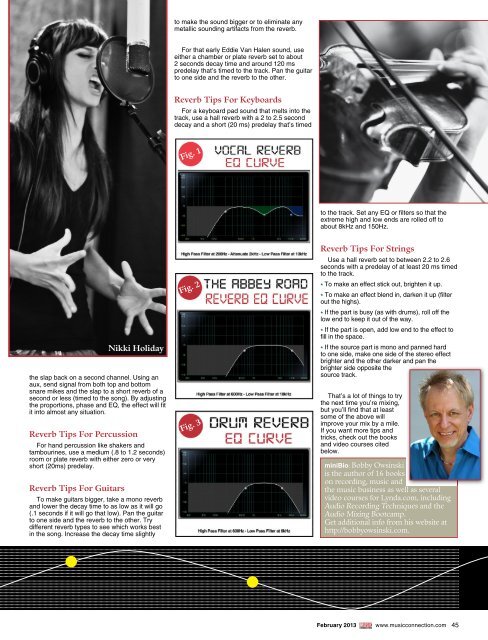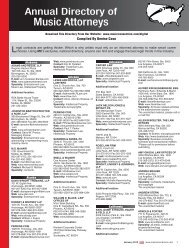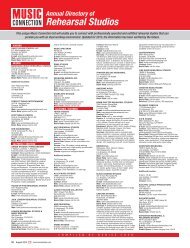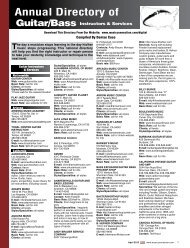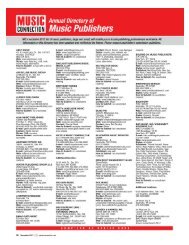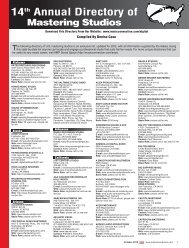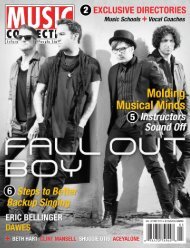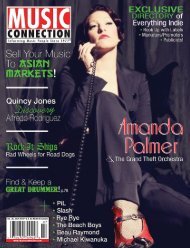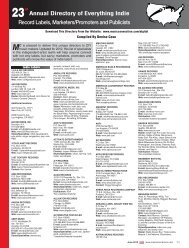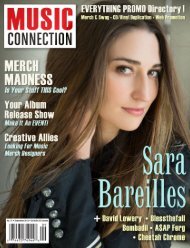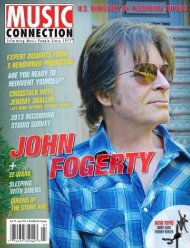www.musicconnection.com
February 2013 - Music Connection
February 2013 - Music Connection
- No tags were found...
Create successful ePaper yourself
Turn your PDF publications into a flip-book with our unique Google optimized e-Paper software.
to make the sound bigger or to eliminate any<br />
metallic sounding artifacts from the reverb.<br />
For that early Eddie Van Halen sound, use<br />
either a chamber or plate reverb set to about<br />
2 seconds decay time and around 120 ms<br />
predelay that’s timed to the track. Pan the guitar<br />
to one side and the reverb to the other.<br />
Reverb Tips For Keyboards<br />
For a keyboard pad sound that melts into the<br />
track, use a hall reverb with a 2 to 2.5 second<br />
decay and a short (20 ms) predelay that’s timed<br />
Fig. 1<br />
to the track. Set any EQ or filters so that the<br />
extreme high and low ends are rolled off to<br />
about 8kHz and 150Hz.<br />
Nikki Holiday<br />
the slap back on a second channel. Using an<br />
aux, send signal from both top and bottom<br />
snare mikes and the slap to a short reverb of a<br />
second or less (timed to the song). By adjusting<br />
the proportions, phase and EQ, the effect will fit<br />
it into almost any situation.<br />
Reverb Tips For Percussion<br />
For hand percussion like shakers and<br />
tambourines, use a medium (.8 to 1.2 seconds)<br />
room or plate reverb with either zero or very<br />
short (20ms) predelay.<br />
Reverb Tips For Guitars<br />
To make guitars bigger, take a mono reverb<br />
and lower the decay time to as low as it will go<br />
(.1 seconds if it will go that low). Pan the guitar<br />
to one side and the reverb to the other. Try<br />
different reverb types to see which works best<br />
in the song. Increase the decay time slightly<br />
Fig. 2<br />
Fig. 3<br />
Reverb Tips For Strings<br />
Use a hall reverb set to between 2.2 to 2.6<br />
seconds with a predelay of at least 20 ms timed<br />
to the track.<br />
* To make an effect stick out, brighten it up.<br />
* To make an effect blend in, darken it up (filter<br />
out the highs).<br />
* If the part is busy (as with drums), roll off the<br />
low end to keep it out of the way.<br />
* If the part is open, add low end to the effect to<br />
fill in the space.<br />
* If the source part is mono and panned hard<br />
to one side, make one side of the stereo effect<br />
brighter and the other darker and pan the<br />
brighter side opposite the<br />
source track.<br />
That’s a lot of things to try<br />
the next time you’re mixing,<br />
but you’ll find that at least<br />
some of the above will<br />
improve your mix by a mile.<br />
If you want more tips and<br />
tricks, check out the books<br />
and video courses cited<br />
below.<br />
miniBio: Bobby Owsinski<br />
is the author of 16 books<br />
on recording, music and<br />
the music business as well as several<br />
video courses for Lynda.<strong>com</strong>, including<br />
Audio Recording Techniques and the<br />
Audio Mixing Bootcamp.<br />
Get additional info from his website at<br />
http://bobbyowsinski.<strong>com</strong>.<br />
February 2013 <strong>www</strong>.<strong>musicconnection</strong>.<strong>com</strong> 45


